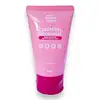What's inside
What's inside
 Key Ingredients
Key Ingredients

 Benefits
Benefits

 Concerns
Concerns

 Ingredients Side-by-side
Ingredients Side-by-side

Niacinamide
SmoothingPolyacrylamide
C13-14 Isoparaffin
EmollientLaureth-7
EmulsifyingGlycerin
HumectantPersea Gratissima Oil
Skin ConditioningCyclopentasiloxane
EmollientDimethicone Crosspolymer
Emulsion StabilisingDimethiconol
EmollientSaccharide Isomerate
HumectantCentella Asiatica Leaf Extract
Skin ConditioningOctyldodecanol
EmollientLeptospermum Scoparium Branch/Leaf Oil
TonicPiper Nigrum Seed Extract
RefreshingMagnolia Officinalis Bark Extract
AntimicrobialPhenoxyethanol
PreservativeEthylhexylglycerin
Skin ConditioningAcrylates/C10-30 Alkyl Acrylate Crosspolymer
Emulsion StabilisingAlpha-Arbutin
AntioxidantButylene Glycol
HumectantWater
Skin ConditioningCryptomeria Japonica Bud Extract
Skin ConditioningPentylene Glycol
Skin ConditioningPhospholipids
Skin ConditioningSphingolipids
EmollientCeramide EOP
Skin ConditioningTriethanolamine
BufferingDisodium EDTA
Niacinamide, Polyacrylamide, C13-14 Isoparaffin, Laureth-7, Glycerin, Persea Gratissima Oil, Cyclopentasiloxane, Dimethicone Crosspolymer, Dimethiconol, Saccharide Isomerate, Centella Asiatica Leaf Extract, Octyldodecanol, Leptospermum Scoparium Branch/Leaf Oil, Piper Nigrum Seed Extract, Magnolia Officinalis Bark Extract, Phenoxyethanol, Ethylhexylglycerin, Acrylates/C10-30 Alkyl Acrylate Crosspolymer, Alpha-Arbutin, Butylene Glycol, Water, Cryptomeria Japonica Bud Extract, Pentylene Glycol, Phospholipids, Sphingolipids, Ceramide EOP, Triethanolamine, Disodium EDTA
Water
Skin ConditioningLauryl Glucoside
CleansingDisodium Laureth Sulfosuccinate
CleansingCocamidopropyl Betaine
CleansingGlycerin
HumectantButylene Glycol
HumectantPolyquaternium-10
Centella Asiatica Leaf Water
Skin ConditioningSodium Hyaluronate
HumectantSodium Hyaluronate Crosspolymer
HumectantHydrolyzed Hyaluronic Acid
HumectantHyaluronic Acid
HumectantHydrolyzed Sodium Hyaluronate
Skin ConditioningCentella Asiatica Extract
CleansingPropolis Extract
Skin ConditioningAsiaticoside
AntioxidantMadecassoside
AntioxidantAsiatic Acid
Skin ConditioningMadecassic Acid
Skin ConditioningPentylene Glycol
Skin ConditioningEthylhexylglycerin
Skin ConditioningCitric Acid
BufferingSodium Benzoate
MaskingSodium Chloride
MaskingCaprylyl Glycol
EmollientDisodium EDTA
1,2-Hexanediol
Skin ConditioningWater, Lauryl Glucoside, Disodium Laureth Sulfosuccinate, Cocamidopropyl Betaine, Glycerin, Butylene Glycol, Polyquaternium-10, Centella Asiatica Leaf Water, Sodium Hyaluronate, Sodium Hyaluronate Crosspolymer, Hydrolyzed Hyaluronic Acid, Hyaluronic Acid, Hydrolyzed Sodium Hyaluronate, Centella Asiatica Extract, Propolis Extract, Asiaticoside, Madecassoside, Asiatic Acid, Madecassic Acid, Pentylene Glycol, Ethylhexylglycerin, Citric Acid, Sodium Benzoate, Sodium Chloride, Caprylyl Glycol, Disodium EDTA, 1,2-Hexanediol
 Reviews
Reviews

Ingredients Explained
These ingredients are found in both products.
Ingredients higher up in an ingredient list are typically present in a larger amount.
Butylene Glycol (or BG) is used within cosmetic products for a few different reasons:
Overall, Butylene Glycol is a safe and well-rounded ingredient that works well with other ingredients.
Though this ingredient works well with most skin types, some people with sensitive skin may experience a reaction such as allergic rashes, closed comedones, or itchiness.
Learn more about Butylene GlycolDisodium EDTA plays a role in making products more stable by aiding other preservatives.
It is a chelating agent, meaning it neutralizes metal ions that may be found in a product.
Disodium EDTA is a salt of edetic acid and is found to be safe in cosmetic ingredients.
Learn more about Disodium EDTAEthylhexylglycerin (we can't pronounce this either) is commonly used as a preservative and skin softener. It is derived from glyceryl.
You might see Ethylhexylglycerin often paired with other preservatives such as phenoxyethanol. Ethylhexylglycerin has been found to increase the effectiveness of these other preservatives.
Glycerin is already naturally found in your skin. It helps moisturize and protect your skin.
A study from 2016 found glycerin to be more effective as a humectant than AHAs and hyaluronic acid.
As a humectant, it helps the skin stay hydrated by pulling moisture to your skin. The low molecular weight of glycerin allows it to pull moisture into the deeper layers of your skin.
Hydrated skin improves your skin barrier; Your skin barrier helps protect against irritants and bacteria.
Glycerin has also been found to have antimicrobial and antiviral properties. Due to these properties, glycerin is often used in wound and burn treatments.
In cosmetics, glycerin is usually derived from plants such as soybean or palm. However, it can also be sourced from animals, such as tallow or animal fat.
This ingredient is organic, colorless, odorless, and non-toxic.
Glycerin is the name for this ingredient in American English. British English uses Glycerol/Glycerine.
Learn more about GlycerinPentylene glycol is typically used within a product to thicken it. It also adds a smooth, soft, and moisturizing feel to the product. It is naturally found in plants such as sugar beets.
The hydrophilic trait of Pentylene Glycol makes it a humectant. As a humectant, Pentylene Glycol helps draw moisture from the air to your skin. This can help keep your skin hydrated.
This property also makes Pentylene Glycol a great texture enhancer. It can also help thicken or stabilize a product.
Pentylene Glycol also acts as a mild preservative and helps to keep a product microbe-free.
Some people may experience mild eye and skin irritation from Pentylene Glycol. We always recommend speaking with a professional about using this ingredient in your routine.
Pentylene Glycol has a low molecular weight and is part of the 1,2-glycol family.
Learn more about Pentylene GlycolWater. It's the most common cosmetic ingredient of all. You'll usually see it at the top of ingredient lists, meaning that it makes up the largest part of the product.
So why is it so popular? Water most often acts as a solvent - this means that it helps dissolve other ingredients into the formulation.
You'll also recognize water as that liquid we all need to stay alive. If you see this, drink a glass of water. Stay hydrated!
Learn more about Water